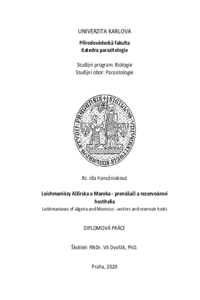Leishmaniózy Alžírska a Maroka - prenášači a rezervoároví hostitelia
Leishmaniases of Algeria and Morocco - vectors and reservoir hosts
Leishmaniózy Alžírska a Maroka - přenašeči a rezervoároví hostitelé
diplomová práce (OBHÁJENO)

Zobrazit/
Trvalý odkaz
http://hdl.handle.net/20.500.11956/119893Identifikátory
SIS: 208696
Kolekce
- Kvalifikační práce [20304]
Autor
Vedoucí práce
Oponent práce
Kočišová, Alica
Fakulta / součást
Přírodovědecká fakulta
Obor
Parazitologie
Katedra / ústav / klinika
Katedra parazitologie
Datum obhajoby
20. 7. 2020
Nakladatel
Univerzita Karlova, Přírodovědecká fakultaJazyk
Slovenština
Známka
Výborně
Jedným z významných zanedbávaných tropických ochorení je leishmanióza. Tá sa vyskytuje v Starom i v Novom svete, kde postihuje stovky tisíc ľudí ročne. V Starom svete pre ľudí nebezpečné leishmánie prenáša rod Phlebotomus, v Novom svete rod Lutzomyia. Medzi tri hlavné formy prejavu ochorenia patrí kutánna, mukokutánna a viscerálna leishmanióza. Alžírsko je každoročne druhé na svete v počtoch prípadov kutánnej leishmaniózy. V Maroku je ročne prípadov menej, ale aj tam je leishmanióza bežným ochorením. Porozumenie prenosovému cyklu v ohnisku nákazy môže viesť k lepšej prevencii ochorenia. Na území Maroka a Alžírska sa vyskytuje Leishmania major, ktorá spôsobuje zoonotickú kutánnu leishmaniózu a prenáša ju Phlebotomus papatasi, L. tropica, ktorá spôsobuje antroponotickú kutánnu leishmaniózu a prenáša ju P. sergenti a L. infantum, ktorá spôsobuje zoonotickú viscerálnu leishmaniózu a prenášajú ju niektoré druhy podrodu Larroussius, napríklad P. perniciosus či P. perfiliewi. Medzi rezervoárové organizmy sa radia hlodavce, psi a človek. V minulosti bolo druhové určenie flebotomov závislé na morfologických kľúčoch. V súčasnosti sú využívané aj metódy druhového určenia na základe molekulárnej diagnostiky. Medzi najznámejšie patrí DNA barcoding, ktorý amplifikáciou špecifického úseku cytochróm oxidázy I...
Leishmaniasis is one of the major neglected tropical diseases, which occurs in both the Old and New Worlds, affecting hundreds of thousands of people annually. In the Old World, human-infecting leishmanias are transmitted by sand flies of the genus Phlebotomus, whereas in the New World by species of the genus Lutzomyia. The disease has three main clinical manifestations, namely cutaneous, mucocutaneous, and visceral leishmaniasis. Algeria is year after year ranked second in the number of cases of cutaneous leishmaniasis. In Morocco, the number of cases per year is lower, however, leishmaniasis is there also a common disease. Understanding the transmission cycles in the foci of the infection may lead to better prevention of the disease. In Morocco and Algeria, these Leishmania species occur: Leishmania major which causes zoonotic cutaneous leishmaniasis and is transmitted by Phlebotomus papatasi, L. tropica, causative agent of anthroponotic cutaneous leishmaniasis transmitted by P. sergenti and L. infantum which causes zoonotic visceral leishmaniasis and is transmitted by several of the subgenus Larroussius, for instance P. perniciosus or P. perfiliewi. Reservoir organisms include rodents, dogs and humans. In the past, the species identification of sand flies depended on morphological keys. At...
